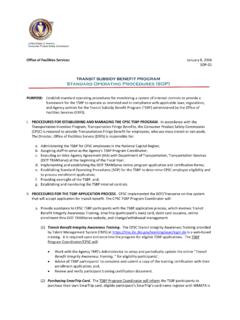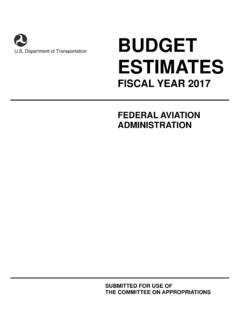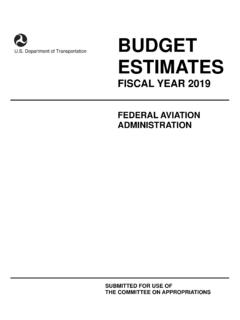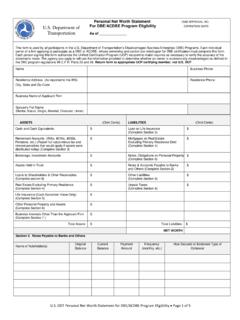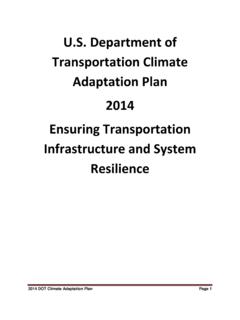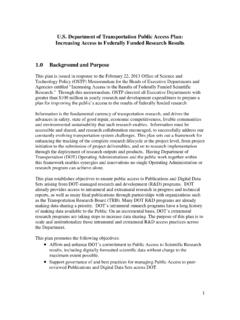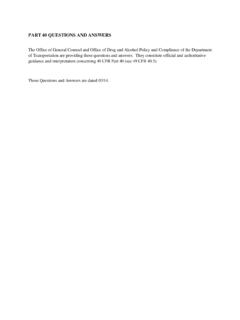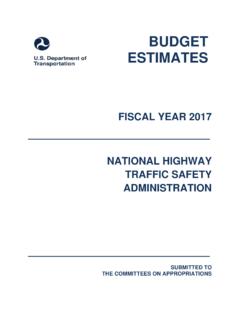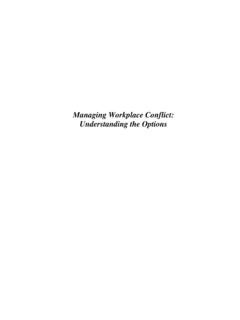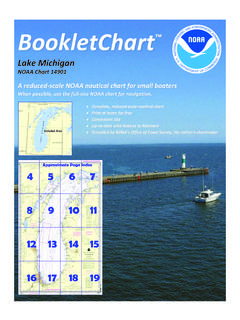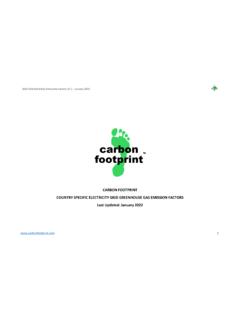Transcription of Weather and Aviation: How Does Weather Affect the Safety ...
1 Kulesa 1 The Potential Impacts of Climate Change on Transportation Weather and Aviation: How Does Weather Affect the Safety and Operations of Airports and Aviation, and How Does FAA Work to Manage Weather -related Effects? By Gloria Kulesa Weather Impacts On Aviation Introduction ccording to FAA statistics, Weather is the cause of approximately 70 percent of the delays in the National Airspace System (NAS). Figure 1 illustrates that while Weather delays declined with overall NAS delays after September 11th, 2001, delays have since returned to near-record levels. In addition, Weather continues to play a significant role in a number of aviation accidents and incidents.
2 While National Transportation Safety Board (NTSB) reports most commonly find human error to be the direct accident cause, Weather is a primary contributing factor in 23 percent of all aviation accidents. The total Weather impact is an estimated national cost of $3 billion for accident damage and injuries, delays, and unexpected operating costs. 0100002000030000400005000060000 Jan 01 Mar 01 May 01 Jul 01 Sep 01 Nov 01 Jan 02 Mar 02 May 02 Weather DelaysOther Delays Figure 1. Delay hours in the National Airspace System for January 2001 to July 2002. Delay hours peaked at 50,000 hours per month in August 2001, declined to less than 15,000 per month for the months following September 11, but exceeded 30,000 per month in the summer of 2002.
3 Weather delays comprise the majority of delays in all Weather and Aviation: How Does Weather Affect the Safety and Operations of Airports and Aviation, and How Does FAA Work to Manage Weather -related Effects? The Potential Impacts of Climate Change on Transportation Thunderstorms and Other Convective Weather . Hazards associated with convective Weather include thunderstorms with severe turbulence, intense up- and downdrafts, lightning, hail, heavy precipitation, icing, wind shear, microbursts, strong low-level winds, and tornadoes. According to National Aviation Safety Data Analysis Center (NASDAC) analysis, between 1989 and early 1997, thunderstorms were listed as a contributing factor in 2-4 percent of Weather -related accidents, depending on the category of aircraft involved.
4 Precipitation was listed as a factor in 6 percent of commercial air carrier accidents, roughly 10 percent of general aviation accidents, and nearly 19 percent of commuter/air taxi accidents. American Airlines has estimated that 55 percent of turbulence incidents are caused by convective Weather . In addition to Safety , convective Weather poses a problem for the efficient operation of the NAS. Thunderstorms and related phenomena can close airports, degrade airport capacities for acceptance and departure, and hinder or stop ground operations. Convective hazards en route lead to rerouting and diversions that result in excess operating costs and lost passenger time.
5 Lightning and hail damage can remove aircraft from operations and result in both lost revenues and excess maintenance costs. In Figure 1, the vast majority of the warm season delays are due to convective Weather . In-Flight Icing. In the period 1989-early 1997, the NTSB indicated that in-flight icing was a contributing or causal factor in approximately 11 percent of all Weather -related accidents among general aviation aircraft. Icing was cited in roughly 6 percent of all Weather -related accidents among air taxi/commuter and agricultural aircraft. The percentage was 3 percent for commercial air carrier accidents.
6 The 1994 crash of an ATR-72 near Roselawn, Indiana, which claimed 68 lives, took place during icing conditions. In-flight icing is not only dangerous, but also has a major impact on the efficiency of flight operations. Rerouting and delays of commercial carriers, especially regional carriers and commuter airlines, to avoid icing conditions lead to late arrivals and result in a ripple effect throughout the NAS. Diversions en route cause additional fuel and other costs for all classes of aircraft. Icing poses a danger to aircraft in several ways: Structural icing on wings and control surfaces increases aircraft weight, degrades lift, generates false instrument readings, and compromises control of the aircraft.
7 See Figure 2. Mechanical icing in carburetors, engine air intakes, and fuel cells impairs engine performance, leading to reduction of power. Figure 2. Photo of structural icing on an aircraft s wing. Kulesa 3 The Potential Impacts of Climate Change on Transportation Small aircraft routinely operate at altitudes where temperatures and clouds are most favorable for ice formation, making these aircraft vulnerable to icing for long periods of time. Larger aircraft are at risk primarily during ascent from and descent into terminal areas. Turbulence. Non-convective turbulence is a major aviation hazard. All aircraft are vulnerable to turbulent motions.
8 Non-convective turbulence can be present at any altitude and in a wide range of Weather conditions, often occurring in relatively clear skies as clear-air turbulence. Any aircraft entering turbulent conditions is vulnerable to damage; smaller aircraft (both fixed- and rotary-wing) are susceptible at lower levels of turbulent intensity than are large aircraft. See Figure 3. The effects of turbulence range from a jostling of the aircraft that is mildly discomforting for passengers and crews to sudden accelerations that can result in serious injury and temporary loss of aircraft control.
9 Recently an air carrier en route from Japan to the encountered turbulence which caused the death of a passenger. Clear-air turbulence is not only dangerous, it also has a major impact on the efficiency of flight operations due to rerouting and delays of aircraft. Ceiling and Visibility. Low ceiling and reduced visibility are Safety hazards for all types of aviation. The NASDAC study of NTSB statistics indicated that ceiling and visibility were cited as contributing factors in 24 percent of all general aviation accidents between 1989 and early 1997. They were also cited as contributing factors in 37 percent of commuter/air taxi accidents during the same period.
10 Low ceiling and poor visibility accidents occur when pilots who are not properly rated or are flying an aircraft not equipped with the necessary instrumentation encounter such conditions, resulting in loss of control, or controlled flight into terrain. Figure 3. Photo of an aircraft missing an engine which had been torn off by turbulence. 4 Weather and Aviation: How Does Weather Affect the Safety and Operations of Airports and Aviation, and How Does FAA Work to Manage Weather -related Effects? The Potential Impacts of Climate Change on Transportation The NTSB statistics also imply that air carriers have the expertise, procedures, and equipment necessary to fly safely in reduced visibility conditions.
